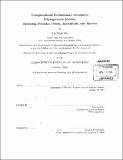| dc.contributor.advisor | Manolis Kellis. | en_US |
| dc.contributor.author | Wu, Yi-Chieh, Ph. D. Massachusetts Institute of Technology | en_US |
| dc.contributor.other | Massachusetts Institute of Technology. Department of Electrical Engineering and Computer Science. | en_US |
| dc.date.accessioned | 2014-06-13T22:34:25Z | |
| dc.date.available | 2014-06-13T22:34:25Z | |
| dc.date.copyright | 2014 | en_US |
| dc.date.issued | 2014 | en_US |
| dc.identifier.uri | http://hdl.handle.net/1721.1/87937 | |
| dc.description | Thesis: Ph. D., Massachusetts Institute of Technology, Department of Electrical Engineering and Computer Science, 2014. | en_US |
| dc.description | Cataloged from PDF version of thesis. | en_US |
| dc.description | Includes bibliographical references (pages 205-216). | en_US |
| dc.description.abstract | Computational techniques have long been applied to biological data to address a wide range of evolutionary questions. In phylogenetics, methods for reconstructing gene histories from sequence data have enabled researchers to better understand how evolution shapes gene content; for example, the identification of evolutionarily-related genes has allowed for the mapping of functions across species and the discovery of novel functions. Such predictions have become increasingly important over the last ten to fifteen years, as technology has reduced the cost of sequencing and increased processing power, leading to vast genomic datasets with little, if any, functional information. In turn, the growing availability of genomes has led to increased power for biological signal discovery and revealed insight into the core evolutionary forces that govern our existence. However, to realize the full potential in genomic and evolutionary studies, we require accurate, efficient, and scalable methods that are widely applicable. In this thesis, I address this need by developing novel computational approaches for reconstructing gene evolutionary histories. In particular, I consider models for gene family evolution that take into account (1) nucleotide or amino acid substitution, (2) genetic drift (leading to deep coalescence), (3) gene duplication and loss, (4) horizontal gene transfer, and (5) domain rearrangement, and I present new phylogenetic algorithms for (1) eukaryotic gene tree reconstruction, (2) prokaryotic gene tree reconstruction, (3) gene tree-species tree reconciliation, and (4) sub-gene-level reconstruction. Through extensive benchmarking, I show that these methods dramatically improve reconstructions compared to stateof- the-art programs; in addition, they are efficient and require few modeling assumptions or parameters, making them applicable to a broad range of species and large datasets. As evidence, I apply these methods to clades of 12 Drosophila, 16 fungi, 15 primates, and 11 cyanobacteria, as well as to simulated phylogenies with up to 200 taxa, and demonstrate the large impact of accurate phylogenetic inference on downstream evolutionary analyses. These results demonstrate the power of computational phylogenetics, and I believe that with the continued development and adoption of such methods, we can address fundamental biological questions with many important implications for future investigations of gene and genome evolution. | en_US |
| dc.description.statementofresponsibility | by Yi-Chieh Wu. | en_US |
| dc.format.extent | 216 pages | en_US |
| dc.language.iso | eng | en_US |
| dc.publisher | Massachusetts Institute of Technology | en_US |
| dc.rights | M.I.T. theses are protected by copyright. They may be viewed from this source for any purpose, but reproduction or distribution in any format is prohibited without written permission. See provided URL for inquiries about permission. | en_US |
| dc.rights.uri | http://dspace.mit.edu/handle/1721.1/7582 | en_US |
| dc.subject | Electrical Engineering and Computer Science. | en_US |
| dc.title | Computational evolutionary genomics : phylogenomic models spanning domains, genes, individuals, and species | en_US |
| dc.type | Thesis | en_US |
| dc.description.degree | Ph. D. | en_US |
| dc.contributor.department | Massachusetts Institute of Technology. Department of Electrical Engineering and Computer Science | |
| dc.identifier.oclc | 880145853 | en_US |
